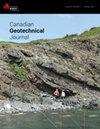Seasonal hydrology and gas transport in a composite cover on sulfide tailings
IF 3.5
3区 工程技术
Q2 ENGINEERING, GEOLOGICAL
引用次数: 1
Abstract
This study presents the field performance of a five-layer composite cover to mitigate acid mine drainage in legacy sulfide tailings in northern Ontario, Canada. Installed in 2008, this cover comprised sand, clay, geosynthetic clay liner, sand, and waste rock layers. To evaluate the effectiveness of the cover in reducing water and oxygen ingress, groundwater and vadose zone hydrological characterization, stable water isotope analysis, pore-gas measurements, oxygen flux calculations, and variably saturated flow modelling were conducted. Results indicate that the clay layer stayed nearly saturated in the spring, fall, and winter, but temporary desiccation occurred during the summer. Compared to uncovered tailings, the cover significantly lowered diffusive oxygen flux. In the summer, fall, and winter, the capillary barrier effect of the cover functioned effectively and inhibited percolation. Atmospheric pore-gas oxygen concentrations at one out of three monitoring locations indicate potential cover imperfections that enabled oxygen transport into the tailings. In the spring and early summer, snowmelt infiltration resulted in percolation that compromised the capillary barrier effect, as well as lateral drainage. The resulting increase in water saturation in the cover limited oxygen transport. Despite potential cover imperfections, this composite cover reduced oxygen and water ingress a decade after installation.硫化物尾矿复合覆盖层的季节性水文和气体输送
本研究介绍了加拿大安大略省北部遗留硫化物尾矿中五层复合保护层的现场性能。该井盖安装于2008年,由砂、粘土、土工合成粘土衬垫、砂和废岩层组成。为了评估覆盖层在减少水和氧进入方面的有效性,进行了地下水和渗透带水文表征、稳定水同位素分析、孔隙气体测量、氧通量计算和变饱和流模拟。结果表明:春、秋、冬三季黏土层基本处于饱和状态,夏季发生暂时性干燥;与未覆盖的尾矿相比,覆盖层显著降低了扩散氧通量。夏、秋、冬三季,覆盖层的毛细阻隔作用有效发挥,有效抑制渗透。三分之一监测点的大气孔隙-气体氧浓度表明潜在的覆盖缺陷使氧气能够输送到尾矿中。在春季和初夏,融雪入渗导致了毛细血管屏障作用的渗透和侧向排水。由此导致的水饱和度的增加限制了氧气的输送。尽管存在潜在的保护层缺陷,但这种复合保护层在安装10年后减少了氧气和水的进入。
本文章由计算机程序翻译,如有差异,请以英文原文为准。
求助全文
约1分钟内获得全文
求助全文
来源期刊

Canadian Geotechnical Journal
地学-地球科学综合
CiteScore
7.20
自引率
5.60%
发文量
163
审稿时长
7.5 months
期刊介绍:
The Canadian Geotechnical Journal features articles, notes, reviews, and discussions related to new developments in geotechnical and geoenvironmental engineering, and applied sciences. The topics of papers written by researchers and engineers/scientists active in industry include soil and rock mechanics, material properties and fundamental behaviour, site characterization, foundations, excavations, tunnels, dams and embankments, slopes, landslides, geological and rock engineering, ground improvement, hydrogeology and contaminant hydrogeology, geochemistry, waste management, geosynthetics, offshore engineering, ice, frozen ground and northern engineering, risk and reliability applications, and physical and numerical modelling.
Contributions that have practical relevance are preferred, including case records. Purely theoretical contributions are not generally published unless they are on a topic of special interest (like unsaturated soil mechanics or cold regions geotechnics) or they have direct practical value.
 求助内容:
求助内容: 应助结果提醒方式:
应助结果提醒方式:


